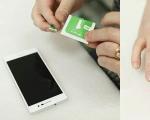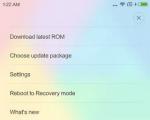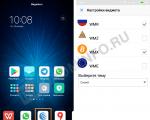Gluing glass to the phone. How to stick protective glass on a smartphone. How to remove protective glass from a phone screen? Removing the old broken protective glass
To protect the screen of your device, you need to know how to apply protective glass to your phone. It is much more durable, but at the same time flexible.
The film can only protect the display from scratches, and the protective screen also prevents the formation of cracks after the smartphone is dropped.
You should be very careful when purchasing universal glass; it may be of poor quality.
Some tips for choosing:
- There are two types of glass: glossy and matte. The first option is cheaper, however, it can only protect the smartphone display from impacts. Before purchasing, check the strength of the glass; it should not bend too much;
- Frosted glass is more expensive and can protect the phone from shocks, falls, and even glare. The disadvantage of such glass is that the color rendering quality of the smartphone display may deteriorate;
- Good glass should have an oleophobic coating. It prevents the coating from getting dirty with grease;
- It is advisable to buy glass options that include special napkins and spare protective glasses;
- The thicker the glass, the higher its strength and level of protection for the phone during shocks and falls.
Glass gluing process
Follow the instructions to add additional protective glass to your smartphone:
- First of all, clean your work area. Many instructions for gluing glass are silent about this point, however, it is very important to remove all dust from the working surface. It is there even if you don't see it.
- Take a clean rag and glass cleaner. Wipe the surface and wait until it dries. This way you will remove the maximum amount of dust particles and there will be less chance of them getting under the protective glass;
- Turn off your smartphone during the entire procedure so that the screen does not turn on during the gluing process;
- Take a damp cleaning cloth and wipe your phone's display thoroughly with it. You can purchase such napkins in the hardware department of any store. Wipes for cleaning glasses are also suitable.
- Then wipe the display with a dry cloth to remove streaks and fingerprints;

- Take a protective screen. Peel off the film on it from the side that will be adjacent to the smartphone display;

- Now position the glass - without touching it, position it over the entire screen area. All steps must be done very quickly;

- Now carefully place the glass so that it perfectly covers the surface of the phone and release it. The protective glass will stick on its own. If you have cleaned the display surface well, air and dust will not appear.

What to do if air gets in? If air bubbles still appear, go over the surface of the protective glass with a napkin, pressing lightly so that they go beyond the limits.
After gluing, turn on the smartphone and check the operation of the sensor.
Important! Many smartphone owners are wondering: is it possible to re-stick the protective glass if it comes off? There may be too many dust particles or air under the screen preventing it from sticking. Carefully peel it off, wipe the smartphone display and repeat the sticker procedure again. Reinstalling on an already clean surface may solve the problem.
How to remove the protective glass?
Removing protective glass is much more difficult than removing film. If you glued it incorrectly, remove it using the tab located on the outside of the protective screen.
In most cases, the need to remove the protective shield occurs after a serious fall. When the screen is broken, the glass must be removed as carefully as possible.
The easiest way is to take a plastic card (for example, a regular bank card) and pry off the edge. Then run the card under the entire surface of the screen, detaching it from the device.

Advice! To make the peeling process easier, stick the phone screen in your palms.
A telephone is a rather expensive thing that accompanies us every day. At the same time, I really want to preserve its original appearance for as long as possible and protect it from various damages. The weakest point of a smartphone is the screen. Despite modern technology, the display continues to collect numerous scratches that negatively affect its appearance. The only reliable way to protect your display from scratches is to apply a protective glass. But this is not so easy to do. In order for it to serve for a long time and reliably protect the screen, you need to clearly know how to stick it on the phone.
Of course, employees of cellular communication salons will kindly offer their services. But for this you will need to pay a considerable amount. Therefore, it is better to glue the glass yourself. In addition to the money saved, you can get a good experience. In addition, you will do it yourself more efficiently, since store employees do not have enough time to follow the entire technology of the process.
Advantages of glass over film
Film is much cheaper, but it has a number of disadvantages. Firstly, it wears out and fades faster. Secondly, the film does not protect against chipping upon impact. These parameters are quite enough to purchase glass and reliably protect the device.
The actual advantages of glass include the following parameters:
- it is almost impossible to scratch;
- looks like new for a long time, does not fade, does not wear out;
- reliably protects not only from minor damage, but also from strong mechanical impact;
- securely attached to the display thanks to the silicone base.
In addition to the above advantages, there are some disadvantages:
- increases the thickness of the phone;
- has a high cost compared to alternative methods of protection.
Considering that the shortcomings are not critical, glass always remains the most aesthetic and practical way to protect the screen.
Characteristics of safety glass
At first glance, such protection appears to be a monolithic part, but this is a mistaken opinion. It actually consists of five layers. Moreover, its thickness does not exceed 0.3 millimeters.
The first layer is an oleophobic coating. Thanks to it, your finger glides across the screen with ease, and dirt is removed without much effort. The second layer is protective. It is this that provides a solid base that protects against mechanical damage. The third layer protects against glare. The fourth holds back the fragments, preventing them from flying away if the glass is damaged. The last layer consists of silicone, thanks to which it is securely attached to the surface of the display.
Technology for gluing protective glass
Before you stick the protective glass on your phone, you need to prepare all the necessary equipment. The minimum set of tools consists of an alcohol wipe and a clean, lint-free rag. Also, you need to remember to wash your hands and preferably wipe them with alcohol. This is done in order not to leave stains on the screen and protective glass. Otherwise, you will have to spend a lot of time removing contaminants.
Glass gluing is carried out in several stages:

If everything is done correctly, the procedure can be considered complete and you can enjoy the result.
- If the phone is completely new or recently purchased and still has the factory film on it, then there is no need to degrease and wipe the display. The factory film reliably protects the screen from dust and grease. It is enough to remove it and immediately stick the glass.
- If you didn’t manage to stick it evenly the first time, you can try again. To do this, you need to very carefully unfasten the edge of the glass and remove it from the screen. After this, repeat the procedure according to the instructions. The main thing to remember is that there are few attempts, since after each peeling off the silicone base is damaged.
- If dust gets between the film and the screen, you need to carefully peel off the glass, remove the dirt, and then repeat the gluing procedure.
- If your phone has a previously damaged or completely broken protective glass, you can remove it using any plastic card. This method is the most effective and safest.

At first glance, the process may seem complicated and time-consuming. In fact, the entire procedure will take no more than ten minutes. The main thing is not to be afraid. Using the tips from the article, you can reliably secure your smartphone and gain good experience. The main thing is to believe in yourself and remember that not a single person who glues protective glass has graduated from a specialized institute in this area.
Screen protection is one of the main conditions for the durability of any modern touchscreen smartphone. Due to the fact that the fragile surface may not survive a fall even from a small height, it is better to purchase a suitable coating immediately after purchasing the phone. Due to ease of use, glass is the best choice, since films serve more of a cosmetic function and protect only from scratches, so now we’ll tell you how to stick protective glass on your phone yourself.
Preparatory operations
First of all, you should make sure that the room in which the operation will be performed will be very clean. Even those specks of dust that are suspended in the air can interfere with the successful completion of the procedure. Clinging to the statically magnetized surface of the glass, they will provoke the appearance of air bubbles on its surface, which will be impossible to expel from under it.
Therefore, it is worth doing a few simple things:

- Scissors – useful for cutting tape.
- Any bank card or similar flat item that is wide enough to cover the entire width of the screen.
- A cloth is usually included with the glass itself, but it would be a good idea to prepare your own, preferably made of microfiber so that it absorbs liquids well.
- Scotch tape - for eliminating minor defects.
- Alcohol or other volatile liquid that can quickly degrease the screen surface.
When everything is ready, you can start gluing. It won't take much time if you do everything according to the instructions right away.
It is worth noting that the preparatory stage is practically the main component of the entire process. Step by step it looks like this:

- Degrease the surface. This is a mandatory procedure; any foreign stain will prevent the two flat parts from adhering well.
- After treating with the product, you need to wipe the entire surface of the screen dry. In this case, you will have to make sure that no dust flakes get on it.
- Take the glass and remove the protective film from one of its sides. The stickers on the edges should tell you which side to use - you need to remove the one that is either indicated by the screen icon or the number “1”.
- Match all the cutouts on the glass with the corresponding ones on the screen. Lean it against one of the edges, preferably the bottom or top.
- Gently lower the glass and let it stick to the surface. This process will be visible, it resembles a wave spreading across the screen.
After the protective glass has stuck, carefully examine the resulting result. There should be no bubbles on the surface of the display. If something goes wrong and they are still there, you need to take a card or other flat object and expel the air outside the screen. This may not work if there is a speck of dust inside the bubble. Then you will have to peel off the glass partially and remove the piece with tape. For this it is better to use a regular transparent one. It will not damage the adhesive structure of the surface.
Video instructions for glueing the protective glass correctly and without bubbles
The touch screen is one of the most important parts of a modern smartphone. It is also one of the most vulnerable parts of a mobile device. To protect against scratches and other damage, you can glue glass to your phone. Earlier in the article, the features of using this accessory were discussed, and cases were also cited when the protection works as efficiently as possible. Now the material will tell you how to glass a phone at home.
Unlike film, glass can protect not only from scratches, but also more serious damage (cracks, chips). But to achieve maximum efficiency, you need to take into account the features of gluing glass to touch screens. How to stick protective glass on your phone correctly - read below.
Before you stick the protective glass on your phone, you need to do some preparation. For all manipulations you will need the following tools and means:
- A napkin that does not leave streaks.
- Medical alcohol, glass cleaner or alcohol-containing liquid (vodka, cologne, perfume).
- Thin medical gloves.
- Silicone suction cup (possible without it).

Some of these items (such as a lint-free wipe, alcohol capsule, or alcohol wipe) may come with the glass. If you don’t have them, you can buy a napkin in the hardware department of the store, and alcohol in the same place as gloves, at the pharmacy.
If you do not have gloves, you should wash your hands thoroughly with soap. It is recommended to use laundry or regular toilet soap (not liquid), as they best degrease the surface of the skin. After washing, the skin of your palms can become dry; if you want to avoid this, you can’t do without gloves. Poorly washed hands can leave greasy marks on the surface of the glass.
Gluing of protective glass should be done in a clean and well-lit room, without dust in the air. You can do this in the bathroom, where moisture “binds” dust particles, preventing them from flying freely.
How to stick glass on your phone without bubbles
Gluing glass is in many ways easier than protective film. Thanks to its rigidity, it is less susceptible to the formation of bubbles, and it is easier to position it correctly in relation to all buttons, frames and holes. However, before you stick the protective glass on your phone, you need to remember: it does not like to forgive mistakes.
If a speck of dust gets in and a bubble appears under the film, just peel off its edge and blow out the foreign particles or remove them with tweezers. You can do this several times in a row until the bubbles are completely eliminated. With glass, this option is not always feasible, since it is difficult to peel it off, sometimes it may not be possible to lift one edge, and if you peel it off and paste it several times, the sticky layer may become unusable, and the glass itself may burst.

The film gluing procedure consists of 6 stages:
- Before sticking the protective glass on the phone, the screen needs to be degreased. For this purpose, an alcohol-containing liquid is used. Before working, you should wear medical gloves to avoid accidentally contaminating the screen and glass. Using a cloth soaked in alcohol, you need to thoroughly wipe the screen, leaving no streaks or stains.
- The new glass should be grasped by the edges with two fingers. Do not touch the adhesive layer with your fingers (even with gloves), as this may affect its adhesive properties, impairing the reliability of adhesion. If there is a suction cup, you can grab the glass with it, then the risk of getting fingerprints is reduced to zero.
- You need to remove the protective film from the bottom side, holding the glass at a distance of 5-10 cm from the screen. If you take a greater distance, dust particles may stick to the glass during movement.
- Having aimed, you should slowly bring the glass to the screen. After it begins to set, you need to run a napkin over it in the middle of the screen (from the earpiece to the buttons.
- When the center of the protective glass is stuck to the display, you need to squeeze out the air from under it, moving the napkin from the center line to the edges.
- When the glass is completely stuck, you can remove the transport film covering the top of the glass and feel free to use your smartphone.

Not everyone can do everything “without a hitch” the first time. Sometimes it is not possible to remove all the dust, or a small speck gets in during the gluing process. It can be removed, but it should be done very carefully. After all, if there is a large bend, the glass will burst. Yes, and prying off the edge of the glass is more difficult than when gluing the film.
If trouble does happen, and the dust under the glass prevents it from sticking properly, you need to peel off the edge from the corner closest to the bubble. This can be done with a thin strip of plastic, for example, a bank or discount card. When you pry the edge, you don't need to lift it much. It is enough to leave a gap of a couple of millimeters. You can remove a speck of dust with clean tweezers or blow it out. A can of compressed air, a regular vacuum cleaner or a low-power compressor will do for this.
After the obstacle is eliminated, you can return the edge of the glass to its place. It should be smoothed with the same movements: from the center to the edges.
How to stick glass on a phone with a 2.5D screen
As mentioned in the previous article, for screens with a 2.5D glass sensor, there is little point in using protective glass. It can prevent scratches, but it can withstand impacts only mediocrely, and it doesn’t protect against falls at all. But if the “native” oleophobic coating is of poor quality or has worn off, the glass can restore its sliding properties, making the use of the touchscreen more convenient. 
The procedure for gluing tempered glass onto a 2.5D screen is the same as for conventional sensors (with flat edges). More attention should be paid when purchasing an accessory. The dimensions of the protective glass should be smaller than the dimensions of the front panel of the smartphone. Otherwise, it will block the sanded edges, leaving an air gap around the edges. Such a sight spoils the appearance of the smartphone and worsens the protection.
When gluing protective glass onto a 2.5D screen, you need to pay more attention to aiming and centering the accessory. It is important not only that the holes for speakers, buttons, cameras, etc. match, but also that the edges of the glass do not overlap areas of the screen with sanded edges (see the previous paragraph). Otherwise, all rules and precautions remain in force.
Many iPhone owners try to treat their device as carefully as possible. For this purpose, various covers, bumpers and protective glasses are purchased.
Here we will tell you how to glue protective glass as simply and quickly as possible without “defects” in the process.
How to do it
Before gluing the protective glass, remove the iPhone case. If the iPhone display is already covered with old film or glass, feel free to remove it. Wash your hands thoroughly to avoid getting dirt on the screen.
It is best to glue in a well-lit place so that you can see every speck that gets on the device screen. Well, choose the cleanest possible surface for gluing the glass.
Let's get started
Step 1. Cleaning the iPhone display.

To do this, we use any microfiber cloth so as not to leave anything unnecessary on the screen.
You can also use an alcohol wipe and then wipe the display with a soft microfiber cloth.
Step 2. Additionally, we clean the smartphone screen using the supplied tape or any other sticker.

Simply touch the display with tape and lift it back up. The adhesive surface will collect any remaining dust.

Step 3. Now you need to remove the protective film from the adhesive side of the glass and apply it to the screen.
Important: Hold the glass by the edges to avoid leaving unnecessary marks on it.

Step 4. Carefully place the glass on the iPhone screen.
If the glass is good, it will fit on the smartphone screen on its own. But to be extra sure, you can smooth it out yourself.

We run our finger through the center of the smartphone and begin to smooth it until all the bubbles are removed. If there are any small bubbles left, take a plastic card and, using light pressure, swipe it over the areas where the bubbles formed.

In this tutorial we used Mocoll glass. And it's not just like that

When you look sadly at your iPhone, the display of which is covered with a merciless mesh, it’s too late to think about protection. The manufacturer of protective accessories Mocoll took care of the consumer in advance.
All brand products are designed in such a way that the buyer spends a minimum of time gluing the protective glass.
Considering that the Chinese brand Mocoll () has been producing protective glass for several years, the company’s engineers have thousands of hours spent in research laboratories.
Glass is produced using high-tech equipment and receives a number of important properties during the processing process. Glass from Mocoll:
- They have a thickness of only 0.33 millimeters. Glass is homogeneous and has equal thickness at any point. Among glass manufacturers, Mocoll has one of the lowest percentage of tolerances in production.
- Mocoll glass easily withstands the impact of sharp objects and does not crumble into fragments upon impact.
- Hardness at 9H on the Mohs scale. Only diamond is higher.
- The glass has an oleophobic coating, so after gluing it you will not feel any tactile changes from interacting with the iPhone screen.
- Mocoll supplies its products with a rich package. The kit has everything you need to glue glass without additional purchases or searching for a piece of fabric or plastic card to eliminate bubbles.
Mocoll has several options for protective glass. 2.5D, 3D and advanced development - 3D glass with elastic edges to match the color of the device’s body.

As you can see above, installing Mocoll safety glass is very easy. Due to the presence of a special silicone layer, you don’t have to worry about the appearance of hated bubbles during gluing.




